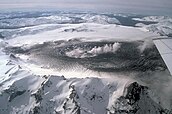Wikipedia:Main Page history/2024 August 14b
From today's featured article
Hudson Volcano is a volcano in the rugged mountains of southern Chile. Lying in the Southern Volcanic Zone of the Andes, it was formed by the subduction of the oceanic Nazca Plate under the continental South American Plate. Hudson has the form of a 10-kilometre-wide (6-mile) volcanic caldera filled with ice. The volcano has erupted numerous times in the past 2.5 million years forming widespread tephra deposits, and is the most active volcano in the region. Four large eruptions have taken place in the past 20,000 years: 17,300–17,440 before present (BP), 7,750 BP, 4,200 BP, and in 1991. The 7,750 BP eruption was among the most intense volcanic eruptions in South America during the Holocene, devastated the local ecosystem and may have caused substantial shifts in human settlement and lifestyle. During the 1991 eruption, volcanic ash covered a large area in Chile and Argentina, and was deposited as far as Antarctica. The last eruption was in 2011. (Full article...)
Did you know ...
- ... that horse and sleigh racing once took place on Ocean Parkway (pictured)?
- ... that islands are home to an estimated 41 percent of land vertebrates at risk of extinction?
- ... that Ken Goldin has sold more than US$1.3 billion in collectibles?
- ... that one of the items on display at the Baltimore Museum and Gallery of Fine Arts was George Washington's shaving brush?
- ... that before Fred Thomas became an MP, he was the Royal Marines' light heavyweight boxing champion?
- ... that Fumika Baba had to learn how to draw for her role in the live-action drama adaptation of Hey Sensei, Don't You Know?
- ... that before becoming a commissioner of Indian affairs, William P. Dole was only known to have encountered Native Americans once in his life?
- ... that the pulse stops during the soliloquy of In C Mali?
- ... that Bolivian intelligence officer Roberto Quintanilla was responsible for cutting off Che Guevara's hands?
In the news

- Voepass Linhas Aéreas Flight 2283 (aircraft pictured) crashes in the Brazilian state of São Paulo, killing all 62 people on board.
- Sheikh Hasina resigns as the prime minister of Bangladesh following anti-government protests, and Muhammad Yunus is appointed leader of an interim government.
- Following a mass stabbing in Southport, far-right protesters riot in England and Northern Ireland.
- The United States, Russia, and their respective allies agree to a prisoner exchange of 26 people.
On this day
August 14: Independence Day in Pakistan (1947)
- 1264 – War of Saint Sabas: A Genoese fleet captured or sank most of the ships of a Venetian trade convoy off the Albanian coast.
- 1816 – The United Kingdom formally annexed the Tristan da Cunha archipelago, administering the islands from the Cape Colony in South Africa.
- 1941 – After a secret meeting in Newfoundland, British prime minister Winston Churchill and U.S. president Franklin D. Roosevelt (both pictured) issued the Atlantic Charter, establishing a vision for a post–World War II world.
- 2021 – A magnitude 7.2 earthquake struck in Haiti, killing at least 2,248 people and causing $1.5 billion in damages and economic loss.
- Qian Hongzuo (b. 928)
- Anders Bure (b. 1571)
- Bobby Eaton (b. 1958)
- Magic Johnson (b. 1959)
Today's featured picture

|
|
The mango is an edible stone fruit produced by the tropical tree Mangifera indica. It originated from the region between northwestern Myanmar, Bangladesh, and northeastern India, and is now cultivated across the world, having been introduced to East Africa by Arab and Persian traders in the 9th to 10th centuries and spread further into other areas around the world during the European colonial era. Ripe mangoes vary according to cultivar in size, shape, color, and sweetness. They have a waxy, smooth, and fragrant skin, which is variously yellow, orange, red, or green, and feature a single flat, oblong pit that can be fibrous or hairy on the surface. The fruits may be somewhat round, oval, or kidney-shaped, ranging from 5 to 25 centimetres (2 to 10 inches) in length and from 140 grams (5 ounces) to 2 kilograms (5 pounds) in weight. It is used in culinary products around the world. The mango is the national fruit of India and M. indica is the national tree of Bangladesh. This photograph shows two mangoes grown in Brazil, one whole and one sectioned. The picture was focus-stacked from 12 separate images. Photograph credit: Ivar Leidus
Recently featured:
|
Other areas of Wikipedia
- Community portal – The central hub for editors, with resources, links, tasks, and announcements.
- Village pump – Forum for discussions about Wikipedia itself, including policies and technical issues.
- Site news – Sources of news about Wikipedia and the broader Wikimedia movement.
- Teahouse – Ask basic questions about using or editing Wikipedia.
- Help desk – Ask questions about using or editing Wikipedia.
- Reference desk – Ask research questions about encyclopedic topics.
- Content portals – A unique way to navigate the encyclopedia.
Wikipedia's sister projects
Wikipedia is written by volunteer editors and hosted by the Wikimedia Foundation, a non-profit organization that also hosts a range of other volunteer projects:
-
Commons
Free media repository -
MediaWiki
Wiki software development -
Meta-Wiki
Wikimedia project coordination -
Wikibooks
Free textbooks and manuals -
Wikidata
Free knowledge base -
Wikinews
Free-content news -
Wikiquote
Collection of quotations -
Wikisource
Free-content library -
Wikispecies
Directory of species -
Wikiversity
Free learning tools -
Wikivoyage
Free travel guide -
Wiktionary
Dictionary and thesaurus
Wikipedia languages
This Wikipedia is written in English. Many other Wikipedias are available; some of the largest are listed below.
-
1,000,000+ articles
-
250,000+ articles
-
50,000+ articles



